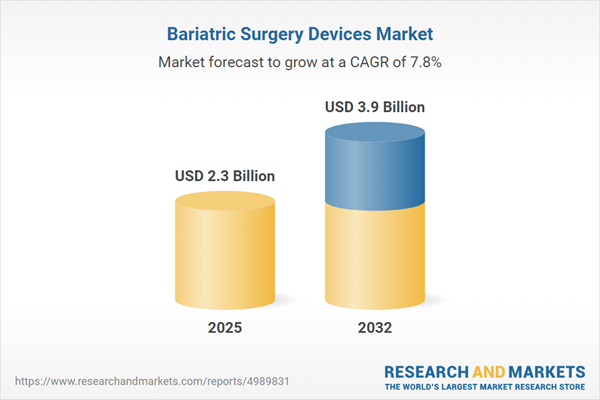Speak directly to the analyst to clarify any post sales queries you may have.
Senior healthcare executives in bariatric surgery face a complex environment where clinical innovation intersects with expanding regulatory standards. Reliable, current market intelligence is crucial for informed decision-making and sustaining operational performance in this rapidly changing sector.
Market Snapshot: Bariatric Surgery Devices Market
The global bariatric surgery devices market reached USD 2.13 billion in 2024, with projections of USD 2.30 billion by 2025 and a potential rise to USD 3.90 billion by 2032. This trajectory represents a compound annual growth rate (CAGR) of 7.84%. The expansion is fueled by increasing adoption of minimally invasive procedures, ongoing device innovations, and advances in perioperative practices. Market competition is characterized by frequent new product introductions, a rise in strategic partnerships, and an emphasis on robust, diversified portfolios. Adaptive regulatory strategies and agile technology assimilation are key as organizations respond to dynamic clinical and operational requirements.
Bariatric Surgery Devices Market: Scope & Segmentation
- Procedure Types: Device offerings address Biliopancreatic Diversion, Endoscopic-based interventions, Gastric Banding, Roux-En-Y Gastric Bypass, and Sleeve Gastrectomy. Each supports specific patient treatment paths, enhancing outcomes for both inpatient and outpatient care settings.
- Surgical Approaches: Laparoscopic, open, and robotic technologies influence investment decision-making and care delivery. Selection shapes clinical workflows, affects patient recovery profiles, and informs capital expenditures in surgical departments.
- Instrument Types: Product portfolios include balloon systems to manage gastric volume, dissection tools for increased accuracy, energy devices for procedural safety, and stapling or suturing devices for consistent closure. Diverse instrumentation drives procedural reliability.
- End Users: Hospitals, clinics, and ambulatory surgical centers base device selection on infrastructure and procedure volume. These choices impact procurement workflows, technology upgrades, and model-of-care adaptation within healthcare systems.
- Distribution Channels: Direct sales networks and third-party distributors are vital for reliable device supply. Thoughtful logistics ensure healthcare providers receive timely deliveries across various markets.
- Regions: The Americas, Europe, Middle East & Africa, and Asia-Pacific regions experience unique challenges tied to regulation, logistics, and operations. Region-specific strategies for compliance and distribution underpin sustainable market presence.
- Key Companies: Leading organizations—including Johnson & Johnson, Medtronic PLC, Intuitive Surgical, Olympus Corporation, Stryker Corporation, Conmed Corporation, Gimmi GmbH, Spatz FGIA Inc., ReShape Lifesciences, and Boston Scientific—drive market development through innovative products and extensive collaborations.
Bariatric Surgery Devices Market: Key Takeaways
- Minimally invasive and robotic techniques are expanding care options and supporting broader implementation in hospitals and ambulatory centers. Adoption is linked to improved patient outcomes and operational efficiency.
- Advancements in device design, especially in energy and suturing technologies, enable customized solutions tailored to a spectrum of clinical needs and diverse patient groups across global markets.
- Procurement priorities now emphasize compliance and rigorous device validation, essential for navigating evolving regulations while upholding operational standards.
- Strengthening digital health integration and optimizing distribution supports stable supply chains and simplifies alignment with industry regulations across regions.
- Smart procurement practices that address local economic and legal contexts drive more effective and scalable device adoption strategies for institutions.
- Continuous professional development and direct collaboration with manufacturers are key to successful technology adoption and standardizing high-quality care delivery.
Tariff Impact: 2025 United States Tariff Measures
Recent US tariffs are introducing new challenges related to cost and supply chain reliability for device manufacturers in the bariatric surgery device market. As a result, healthcare organizations are expanding supplier networks, fostering the use of standardized components, and tightly managing costs. This evolving regulatory context increases the need for price transparency and productive supplier collaboration to ensure continued device access and regulatory compliance.
Methodology & Data Sources
The report draws on primary research, including clinical trial reviews, industry surveys, and regulatory documentation, alongside insights from expert interviews and proprietary forecasting models. A comprehensive secondary literature review supports in-depth analysis of trends, technology advancements, and market activity.
Why This Report Matters
- Delivers bariatric surgery devices market intelligence for benchmarking innovation and refining strategies to achieve operational efficiency.
- Advises procurement leaders on aligning purchasing with compliance and evolving best practices to manage risk and continuity.
- Arms senior executives with actionable insights to optimize operations and care delivery amid regulatory and market transitions.
Conclusion
This report provides healthcare decision-makers with an informed framework to navigate emerging trends, cultivate resilient business models, and maintain strong market positioning as the bariatric surgery devices market evolves.
Additional Product Information:
- Purchase of this report includes 1 year online access with quarterly updates.
- This report can be updated on request. Please contact our Customer Experience team using the Ask a Question widget on our website.
Table of Contents
3. Executive Summary
4. Market Overview
7. Cumulative Impact of Artificial Intelligence 2025
Companies Mentioned
The companies profiled in this Bariatric Surgery Devices market report include:- Johnson & Johnson
- Medtronic PLC
- Intuitive Surgical, Inc.
- Olympus Corporation
- Stryker Corporation
- Conmed Corporation
- Gimmi GmbH
- Spatz FGIA Inc.
- ReShape Lifesciences, Inc.
- Boston Scientific Corporation
Table Information
| Report Attribute | Details |
|---|---|
| No. of Pages | 199 |
| Published | October 2025 |
| Forecast Period | 2025 - 2032 |
| Estimated Market Value ( USD | $ 2.3 Billion |
| Forecasted Market Value ( USD | $ 3.9 Billion |
| Compound Annual Growth Rate | 7.8% |
| Regions Covered | Global |
| No. of Companies Mentioned | 11 |









